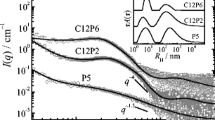Abstract.
Recent observations (Eur. Phys. J. E 9, 135 (2002)) showed that the vitrification process, which sets in during the linear bulk methyl methacrylate (MMA) polymerization carried out below glass transition temperatures, can be modelled by static percolation picture. To generalize this observation for different kind of bulk linear or crosslinked polymers not enough data are present in the literature. To cover partly this deficit we studied the glass transition of MMA and styrene (Sty) crosslinking copolymerization in varying ratios of MMA and Sty. Both the fluorescence intensity I and the lifetime \(\tau \) of pyrene (Py) used as a nanosecond in situ fluoroprobe were monitored during the gelation time. Both I and \(\tau \) increase dramatically as a result of the reduced mobility of the probes trapped in the “glassy” regions, appearing near the glass transition point. The average size of the glassy regions just below, and the strength of the infinite network formed upon the connection of the glassy regions above the glass transition point \(t_{\rm g}\) obey power law relations. The data around \(t_{\rm g}\) were interpreted on the basis of the percolation theory and we observed that the corresponding exponents \(\gamma \) and \(\beta \) give static percolation values independent of the polymer composition.
Similar content being viewed by others
References
J. Qin, W. Guo, Z. Zhang, Polymer 43, 1163 (2002).
Ö. Pekcan, Y. Yılmaz, O. Okay, Polymer 38, 1693 (1997).
O. Okay, D. Kaya, O. Pekcan, Polymer 40, 6179 (1999).
H.K. Mahadabi, K.F. O’Driscol, J. Polym. Sci. Polym. Chem. Ed. 15, 283 (1977).
J. Dionisio, H.K. Mahadabi, K.F. O’Driscol, J. Polym. Sci. Polym. Chem. Ed. 17, 1891 (1979).
I.A. Maxwell, G.T. Russell, Macromol. Theory Simul. 2, 95 (1993).
M.D. Ediger, C.A. Angell, S.R. Nagel, J. Phys. Chem. 100, 13200 (1996).
D. Panke, M. Stickler, W. Wunderlich, Macromol. Chem. 184, 175 (1983).
S. Zhu, Y. Tian, A.E. Hamielec, D.R. Eaton, Polymer 31, 154 (1990).
G.A. O’Neil, J.M. Torkelson, Macromolecules 32, 411 (1999).
G.A. O’Neil, M.B . Wisdual, AIChE J. 44, 1226 (1998).
S. Zhu, A.E. Hamielec, Polymer 32,3021 (1991).
S.T. Balke, A.E. Hamielec, J. Appl. Polym. Sci. 17, 905 (1973).
A.W.T. Hui, A.E. Hamielec, Polymer 16, 749 (1972).
P.F. Jones, S. Siegel, J. Chem. Phys. 50, 1134 (1969).
F.R. Blackburn, C.-Y. Wang, M.D. Ediger, J. Phys. Chem. 100, 18249 (1996).
a) J.-P. Fouassier, Photoinitiation, Photopolymerization and Photocuring (Hanser Publishers, Munich, Viana, New York, 1995) p. 49; b) M.T. Cicerone, F.R. Blackburn, M.D. Ediger, Macromolecules 28, 8224 (1995).
M.T. Cicerone, P.A. Wagner, M.D. Ediger, J. Phys. Chem. B 101, 8727 (1997).
W. Zhu, M.D. Ediger, Macromolecules 30, 1205 (1997).
C.-Y. Wang, M.D. Ediger, J. Phys. Chem. 104, 1724 (2000).
J. -W. Park, M.D. Ediger, M.M. Green, J. Am. Chem. Soc. 123, 49 (2001).
Y. Yılmaz, Y. Yagcı, Ö. Pekcan, J. Macromol. Sci.-Pure Appl. Chem. A 38, 741 (2001).
Ö. Pekcan, Y. Yılmaz, O. Okay, Chem. Phys. Lett. 229, 537 (1994).
Ö. Pekcan, Y. Yılmaz, O. Okay, J. Appl. Polym. Sci. 61, 2279 (1996).
O. Okay, Y. Yılmaz, D. Kaya, M. Keskinel, Ö. Pekcan, Polym. Bull. 43, 425 (1999).
Ö. Pekcan, Y. Yılmaz, Prog. Colloid Polym. Sci. 102, 89 (1996).
Ö. Pekcan, Y. Yılmaz, J. Appl. Polym. Sci. 63, 1777 (1997).
Ö. Pekcan, Y. Yılmaz, Ş. Ugur, Polym. Int. 44, 474 (1997).
Y. Yılmaz, Ö. Pekcan, Polymer 39, 5351 (1998).
O. Guney, Y. Yılmaz, Ö. Pekcan, Sens. Actuators B 85, 86 (2002).
T. Oya, T. Enoki, A. Yu. Grosberg, S. Masamune, Y. Takeoka, K. Tanaka, G. Wang, Y. Yılmaz, T. Tanaka, Science 286, 1543 (1999).
Y. Yılmaz, Phys. Rev. E 66, 052801 (2002).
D. Kaya, Ö. Pekcan, Y. Yılmaz, Phys. Rev. E 69, 016117 (2004).
M. Stickler, Makromol. Chem. 184, 2563 (1983).
J.N. Cardenas, K.F. O’Driscoll, J. Polym. Sci.: Polym. Chem. Ed. 14, 883 (1976); 15, 1883; 2097 (1977).
F.L. Martin, A.E. Hamielec, ACS Symp. Ser. 104, 43 (1979).
P.D. Armitage, S. Hill, A.F. Johnson, J. Mykytiuk, J.M.C. Turner, Polymer 29, 2221 (1988)
K.E. Miller, E.L. Burch, F.D. Lewis, J.M. Torkelson, J. Polym. Sci., Part B: Polym. Phys. 32, 2625 (1994).
Y. Yılmaz, A. Erzan, Ö. Pekcan, Eur. Phys. J. E 9, 135 (2002).
Y. Yılmaz, A. Erzan, Ö. Pekcan, Phys. Rev. E 58, 7487 (1998).
B. Serrano, B. Levenfeld, J. Bravo, J. Baselga, Polym. Eng. Sci. 36, 175 (1996).
Y. Tian, S. Zhu, A.E. Hamielec, D.B. Fulton, D.R. Eaton, Polymer 33, 384 (1992).
F.R. Blackburn, C.Y. Wang, M.D. Ediger, J. Phys. Chem. 100, 18249 (1996).
D. Long, F. Lequeux, Eur. Phys. J. E 4, 371 (2001).
S. Merabia, D. Long, Eur. Phys. J. E 9, 196 (2002).
J. Berriot, H. Montes, F. Lequeux, D. Long, P.Sotta, Macromolecules 35, 9756 (2002).
J. Berriot et al. , Europhys. Lett. 64, 50 (2003).
E. Tuzel, M. Özmetin, Y. Yılmaz, Ö. Pekcan, Eur. Polym. J. 36, 727 (2000).
D. Stauffer, Introduction to Percolation Theory (Taylor and Francis, London, 1985).
Author information
Authors and Affiliations
Corresponding author
Additional information
Received: 9 July 2004, Published online: 1 October 2004
PACS:
64.60.Ak Renormalization-group, fractal, and percolation studies of phase transitions - 64.70.Pf Glass transitions - 82.35.Jk Copolymers, phase transitions, structure
Rights and permissions
About this article
Cite this article
Yılmaz, Y., Kaya, D. & Pekcan, Ö. Can the glass transition in bulk polymers be modeled by percolation picture?. Eur. Phys. J. E 15, 19–25 (2004). https://doi.org/10.1140/epje/i2003-10156-9
Issue Date:
DOI: https://doi.org/10.1140/epje/i2003-10156-9



